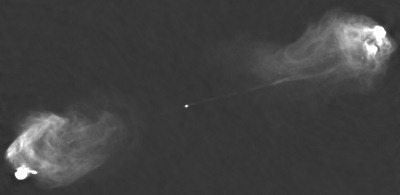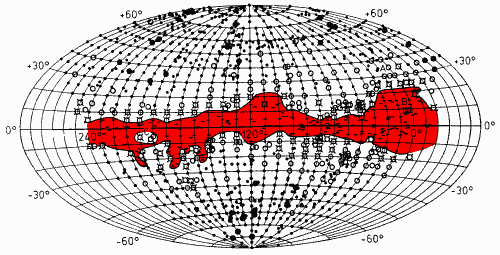

"I was stunned when we realized we had a quasar; it was a total surprise," said Dr. Anne Kinney of the Space Telescope Science Institute, Baltimore, Md. Until this discovery all known quasars existed in the early universe. "So it is unusual to find one in our own epoch," Dr. Kinney said.
The discovery in galaxy Cygnus A will give astronomers their first opportunity for detailed study of a quasar, an object which looks like a pinpoint of light (as does a star) to a ground-based telescope. A quasar, though, emits hundreds of times more energy than an entire galaxy with more than 100 billion stars.
There is evidence that the quasars -- short for "quasi-stellar radio sources" -- found in the remote galaxies are powered by supermassive black holes that devour dust, gas and stars from the host galaxies, producing enormous amounts of energy in the process. Beyond that, little is known about them, which makes this discovery so important.
Dr. Kinney emphasized that this unexpected result implies that all radio galaxies might harbor quasars that are hidden from view.
The observations were made by Robert Antonucci and Todd Hurt of the University of California at Santa Barbara, and Kinney. Their results appear in the September 22 issue of Nature.
Though Cygnus A is categorized as an elliptical galaxy, it has an unusual peanut shape due to a dark band of dust encircling the enigmatic nucleus. The Hubble astronomers could only peek into the core by taking advantage of a natural "periscope effect." Dust outside of the nucleus acts like a mirror to reflect the shorter wavelengths, or blue component, of the light toward Earth.
The astronomers used the ultraviolet sensitivity of the Faint Object Spectrograph to look for the spectral signature of extremely hot, supermassive stars hidden in the nucleus. Such stars are theorized as one possible explanation for Cygnus A's powerful optical emissions.
Instead, the resulting ultraviolet spectrum was so unusual that astronomers puzzled over the data for three months before reaching their startling conclusion. After much analysis, they realized it was in part composed of the typical spectrum of a quasar. Such a spectrum possesses broad emission lines that indicate that gas in the nucleus is swirling at high speeds. "One caveat is that the broad emission line could possibly be many narrow emission lines blended together," Kinney said. "We will double check that possibility with more observations." HST's ultraviolet sensitivity allowed this spectrum to be distinguished more easily from the galaxy's starlight.
Kinney emphasized that it is probably more than coincidence to find a quasar embedded in the nearest extremely powerful radio galaxy to Earth. These results suggest that quasars might be common to radio galaxies and might explain their powerful radio emissions, she added.
Though this provides an unexpected opportunity for close-up study of the mysterious "engine" behind a quasar, these results add further mystery as to the true nature of the powerhouse.
Previous ground-based radio observations show that there is an elongated object in Cygnus A's core. This is inconsistent with black hole models that predict a compact point source of radiation. Supermassive black holes are a leading candidate for explaining a quasar's prodigious outpouring of energy.
The astronomers plan to use the Hubble Space Telescope to study the spectrum of other radio galaxies and look for fingerprints of other quasars.
Sarah Keegan Headquarters, Washington, D.C. September 21, 1994 (Phone: 202/358-1547) Jim Elliott Goddard Space Flight Center, Greenbelt, Md. (Phone: 301/286-6256) Ray Villard Space Telescope Science Institute, Baltimore, Md. (Phone: 410/338-4514) RELEASE: 94-160
The cutting edge of astronomical technique is based on multispectral analysis, studying a region of the sky in as many wavelengths as possible and correlating the data into a coherent picture of the phenomena. Since many quasars emit radiation in a large range of wavelengths throughout the electromagnetic spectrum, it is therefore appropriate to use this successful method in the following attempt to demonstrate that Cygnus-A, a quasar candidate, is within our galaxy:
![Diagram of Optical Brightness Distribution of the Milky Way ]](milkyway.gif) |
| Diagram of the optical brightness distribution of the Milky Way. Units: 1 star of magnitude 10 per square degree (colorized version of diagram originally from Scheffler and Elsasser, 1988). (Cygnus-A is within the second orange blob from the left) |
Not only is this supposedly extra-galactic object less than 6 degrees from the galactic equator, but its longitude of 76 degrees means we are looking straight down the Orion Arm (or Local-Arm, one of the spiral arms in our galaxy which contains the Sun). The Cygnus star cloud is one of the most crowded star fields in the galaxy in the the middle of Cygnus shows that the star density is extremely high, this would produce very large obscuration if the object was a genuine galaxy. The region can be easily be seen with the unaided eye and is called the Cygnus star cloud, a prominent feature in the backbone of the milky-way band.
 |
Cygnus-A StarfieldExtremely dense star cloud surrounding Cygnus-A (at center). The field of view is approximately half the size of the full moon.(Image courtesy of National Geographic's POSS; Palomar Observatory DSS; Digitized Sky Survey) |
 |
| Diagram created by Edwin Hubble (1934) for the visibility of galaxies in galactic coordinates, legend : Small Points: normal density, large points: excess density, circles: deficit, circles with radial lines: gross deficit, red zone: no galaxies = Zone of Avoidance. |
Based on Uranometria star charts, there are no other confirmed galaxies within a 10 degree radius from Cygnus-A. From the chart drawn by Hubble himself, this object fall within the zone he declares as devoid of galaxies. Also note how this 'Zone of Avoidance' corresponds with areas of high stellar luminosity from the diagram of the first section.
 |
| Radio Image at 408-MHz of Galactic Plane region, (Cygnus-A in small box) |
Also, the fact that Cygnus-A is one of the strongest radio sources in the entire sky is an important hint that warrants the careful reviewer to consider the possibility that the object is within our galaxy, otherwise he would have to assume paradoxical power densities and rapid fluctuations. Radio observations show that there is an elongated object in Cygnus A's core. This is inconsistent with black hole models that predict a compact point source of radiation.
This is a strong reason for identifying Cygnus A as a plasma laser star, if the object is nearby, at distances previously estimated for other quasars (Varshni, 1988), this would place it in front of much of the galactic obscuration. Although the discovery of this particular quasar within the traditionally forbidden zone of avoidance within ±10 degrees from the galactic equator is purely serendipidous, as Antonucci et al. (1994) have stated, they were not sure what to make of the spectra for several months until they deduced that it was a quasar.
Many objects confirmed to be within our galaxy have strong radio jets and lobes, such as SS433, GRS1915+105 and GROJ1655-40 which have been dubbed as mini-quasars by Mirabel et al. (1994). Cygnus A is centered within a pair of jets, very similar to these two objects. A milder version of this bipolar outflow has been recently discovered in many planetary and proto-planetary nebula, which are now assumed to be plasma ejections collimated by circumstellar materials, like the optical jets from Young Stellar Objects (YSO) associated with High Velocity Molecular Gas (HVMG) radio lobes in in protostellar condensations. Jets and their associated pair of radio lobes are a very common phenomena within the galaxy, both in very young and very old objects. Laser emission lines have been discovered in many of the central engines of these planetary nebula (Varshni, 1976); this and the similar radio-properties is a clear indication that quasars are objects within our galaxy.
This confirms one of the main predictions of the plasma laser star theory : That quasars will be found in the galactic plane. We predict that many more quasars will be found if a concerted effort is made to search for other quasars in the galactic plane.
Note added in proof: This prediction is confirmed by the recent discovery of the 'micro-quasars' within the galaxy, GRS 1915+105 is less than a quarter of a degree from the galactic plane and GRO J1655-40 is only 2.2 degrees away from the galactic plane.
Mistakes in distance estimation by five orders of magnitude or more such as in the case of Cygnus-A or in the case of the very first quasars (Schmidt, 1965) can throw the rest of the astronomical community into a tailspin from which they have yet to recover.
 Anyone who conducts an argument by appealing to Authority is not using
his intelligence, he is just using his memory.
Anyone who conducts an argument by appealing to Authority is not using
his intelligence, he is just using his memory.